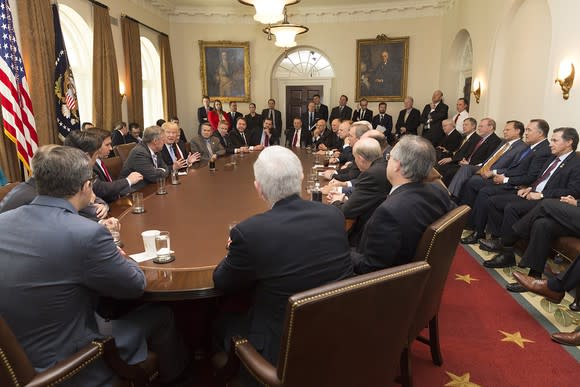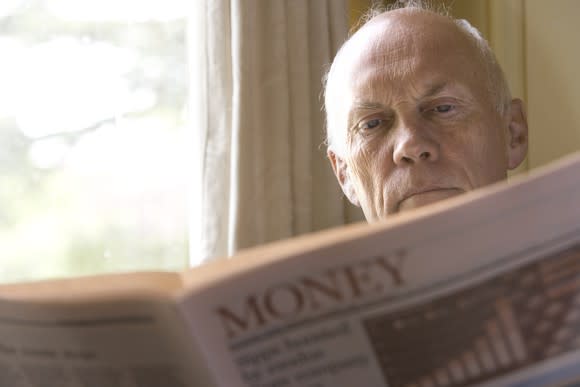Trump's Top Economic Advisor Has a Surprising Take on Social Security
Since Donald Trump took office in January 2017, things have been a bit unorthodox, to say the least. That was to be expected of a president taking office that had neither a political nor a military background. But one hallmark of the Trump presidency thus far has been turnover within his cabinet.
Larry Kudlow becomes Trump's right-hand man on the economy
Among this turnover was the hiring and resignation of former Goldman Sachs executive Gary Cohn, who for 16 months was Trump's White House Chief Economic Advisor. Though the president has demonstrated a penchant for sticking to his own economic agenda on occasion, the position of White House Chief Economic Advisor isn't one to overlook. Whoever takes the position is responsible for providing objective economic advice to the president that could affect the formulation of domestic and international economic policies.

Image source: Official White House Photo by Benjamin Applebaum.
Following Gary Cohn's resignation, that job was offered and accepted by former CNBC commentator Larry Kudlow in mid-March. Trump and Kudlow do see eye to eye on a handful of key economic issues.
For instance, both see reducing the corporate tax rate and putting more money into the pockets of businesses as the single-biggest driver of long-term growth. The belief from both President Trump and Larry Kudlow is that businesses will use this extra capital derived from lower corporate income tax rates to hire more workers, give existing workers raises, and invest in ongoing research and product development. This, in turn, could push U.S. GDP growth to a consistent 3% per year.
But one area where the president and his top economic advisor aren't in agreement is Social Security.
Social Security is careening toward trouble, new report shows
As a quick refresher, Social Security could easily be described as this nation's most important social program. More than 62 million people each month receive a benefit check, and more than 60% of aged beneficiaries (65 years and older) are reliant on the program to provide at least half of their monthly income.
Yet for as important as Social Security is, Congress has twiddled its thumbs as the annually released Trustees reports on Social Security have become grimmer.

Image source: Getty Images.
The latest report estimates that the program will begin paying out more in benefits than it generates in income this year for the first time since 1982. Even though this net cash outflow is expected to total only $1.7 billion in 2018, these outflows are expected to accelerate rapidly in 2020 and with each successive year. By 2034, it's believed that the $2.9 trillion the program has built up in asset reserves will be completely exhausted. Should this excess cash disappear, the program will survive, but an across-the-board cut to current and future retirees' benefits of up to 21% may be necessary.
In each and every year since 1985, the Trustees report has predicted the depletion of the Trust's asset reserves at some point over the next 75 years. Meanwhile, working Americans continue to look to lawmakers in Washington to fix this mess.
Trump's take on Social Security
Interestingly enough, while Donald Trump was exceptionally opinionative on the campaign trail, and since he's taken office, on most issues, he's largely kept his distance from directly addressing the problems facing Social Security.
With the exception of suggesting that America needs to honor its agreement to continue paying Social Security benefits, the closest thing to a direct Social Security quote from Trump was made back in March 2013 at the Conservative Political Action Conference. Said Trump, courtesy of the Washington Times:
As Republicans, if you think you are going to change very substantially for the worse Medicare, Medicaid and Social Security in any substantial way, and at the same time you think you are going to win elections, it just really is not going to happen ... What we have to do and the way solve our problems is to build a great economy.

Image source: Official White House Photo by Andrea Hanks.
In other words, attempting to alter Social Security is too big of a political risk in the eyes of our president. While there are numerous ways to fix Social Security and resolve its estimated $13.2 trillion cash shortfall between 2034 and 2092, each fix means someone is going to lose. Whether the wealthy take it on the chin by paying a higher tax rate, or future generations of workers take a cut to their lifetime benefits via an increase in the full retirement age, someone will lose.
Trump believes the smartest way to tackle Social Security's issues is by cutting tax rates for individuals and corporations and allowing GDP growth to push payroll tax revenue higher. Payroll taxes comprise the lion's share of the revenue generated by Social Security each year.
Kudlow's take on Social Security is markedly different
On the other hand, Trump's top economic advisor has a markedly different view of Social Security.
In January 2007, Larry Kudlow offered his take on Social Security in the online publication National Review. Keeping in mind that these comments are now more than 11 years old, and Kudlow is certainly entitled to have changed his opinion since January 2007, here's what the White House Chief Economic Advisor had to say then:
As far as Social Security is concerned, a set of optimistic (yet eminently reasonable and realistic) economic assumptions exist which lead to no bankruptcy and no trust fund exhaustion. This scenario -- one rarely discussed by most -- includes slightly less than 3 percent real economic growth, and 2 percent productivity per year. Over the next seventy-five years, this solid growth forecast keeps Social Security funds alive and well.
For starters, Kudlow strongly believes that Social Security's doomsday forecast is overstated. He views the ability to grow the U.S. economy at around 3% annually, with the aid of long-term corporate tax cuts, as a means to drive payroll tax growth and ease Social Security's funding concerns.

Image source: Getty Images.
What's more, Kudlow places the blame for Social Security's doomsday forecasts on the anemic growth rate of its asset reserves. Said Kudlow in the same article:
The real problem with Social Security is not bankruptcy. It's the dreadful investment return (barely 1 percent) that future retirees have to look forward to. If Americans had the chance to purchase S&P 500 SPDR contracts, and were able to hold them for fifty years, they would receive a real return of at least 7 percent compounded annually based on the history of the stock market. That's a lot of Benjamins. Heck, even if workers were given a lousy bank deposit option, federally insured by Uncle Sam, they could still count on squeezing out at least 3 percent compound returns.
In plainer English, Kudlow backs the idea of partially or fully privatizing Social Security to allow working Americans control over a portion of their retirement benefit. To be fair, the average rate of return on Social Security's asset reserves is a much healthier 2.9% today. But if working Americans could invest in the stock market over the long term, they would have an opportunity to best this 2.9% return.
The danger with privatization is that the American public isn't very knowledgeable when it comes to understanding investing basics. If low- or middle-income Americans were to get too aggressive when investing their retirement benefit, the possibility exists that they could lose money, thus putting themselves in even worse shape come retirement.
Again, I want to reiterate that these comments by Kudlow are 11 years old, and his thesis on the program may have changed. Let's not forget that nearly two decades ago, Trump also supported the idea of partially privatizing Social Security.
It remains to be seen if Kudlow's take on America's top social program will have any influence on a president who's done everything to avoid directly addressing the problems facing Social Security. Only time will give us that answer.
More From The Motley Fool
Sean Williams has no position in any of the stocks mentioned. The Motley Fool has no position in any of the stocks mentioned. The Motley Fool has a disclosure policy.

 Yahoo Finance
Yahoo Finance 